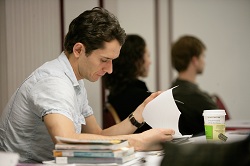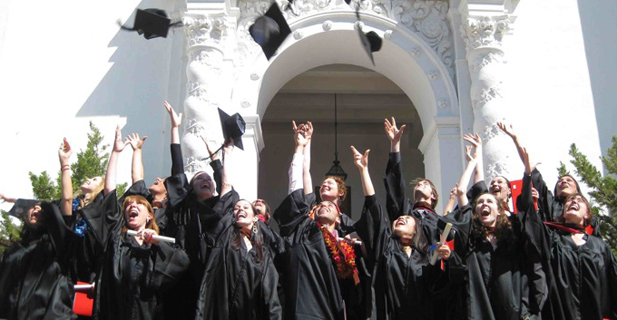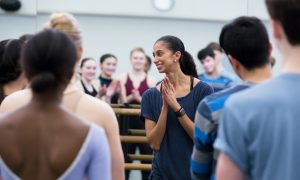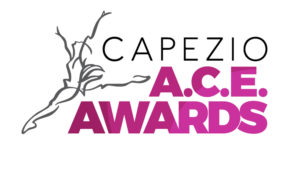By Stephanie Wolf.
Dancers begin their professional careers at young ages, focused solely on the present and success. They push their bodies to extreme measures and, typically, don’t consider the dancer ‘after-life’. But, in reality, the daily grind wears the body down, limiting the longevity of a dancer’s career. What lies beyond a life of curtain calls can be frightening. St. Mary’s College of California Liberal Education for Artist Professionals (known fittingly as LEAP) helps pacify this anxiety by educating current and former dancers and giving them control of their futures.
LEAP Program Director Mark Baird can relate to these feelings. A former dancer and LEAP graduate himself, he knows the value of education and the fear of transitioning into a new career. “So much of [a dancer’s] identity is tied up in dance…It’s our support structure. It’s where our friends are, where our paychecks come from. It’s how we define ourselves,” he explains. “When that gets taken away most dancers are left with ‘Now what?’” After a fruitful dance career with companies such as Pacific Northwest Ballet, Joffrey Ballet, Ballet du Nord in France, and Teatro Comunale di Firenze in Italy, Mark moved back to the States and faced the same question…“Now what?” A brief stint in the corporate world made him realize he wanted to go to school and find a new passion. He joined the first group of LEAP students and became Program Director in 2002.
Claire Sheridan founded LEAP in 1999. A jazz dancer who had to retire “early because of injuries,” Sheridan was teaching at St. Mary’s College (SMC) – a private liberal arts university in Moraga, CA – when she got the inspiration for LEAP. In collaboration with SMC’s Performing Arts Department and the School of Extended Education, Sheridan spearheaded the dancer-specific program, which “paralleled” the university’s Bachelor of Arts and Performing Arts 4-year degree.
The purpose of LEAP is “to make it possible for a current or former professional dancer to access higher education. And, in doing so, gain the confidence and security to be able to transition into new careers.” Generally, “dancers don’t get to go to college because they’re busy dancing.” LEAP offers dancers the flexibility, accessibility, and affordability that traditional colleges don’t, so they can earn a degree in conjunction with their performing careers or upon retirement.

LEAP student Damian Smith. Photo by Erik Tomasson
How LEAP works
“What makes LEAP so successful is the amount of credits students can get for prior experience, including professional experience,” Baird explains. LEAP students can earn up to a year’s worth of college credit for professional dance experience. “Because LEAP students are adult learners, they also have additional life experience…there are ways of writing for credit.” Students can earn up to another 30 credits by writing Experiential Learning Papers. “LEAP students can get up to half of their college credit done by having danced and lived” – accelerating dancers through the program.
At the heart of LEAP is the “core curriculum of academic liberal arts courses [brought] to the dancers”, adds Baird. These courses are comparable to what on campus students take and are offered in hotel conference rooms on evenings that are convenient for dancers to attend. Dancers take 10 core courses to receive their BA in Liberal Studies. Another advantage of LEAP is that the course of study can be “individualized for each student”, says Baird. A student can gear his or her academic path towards their future professional interests, such as business, medical fields, or journalism.
Additionally, SMC makes the program economical for dancers with meager incomes. A traditional SMC undergrad pays $38,000 a year for a 4-year program, while LEAP students pay $24,000 for the entire program. At a fraction of the cost, dancers receive education from one of the nation’s top private colleges. (SMC ranked 172 for best overall undergraduate program in Forbes Magazine’s Top 650 American Colleges.)
The present and future of LEAP
The LEAP program originated in San Francisco and expanded into Los Angeles in 2004. Three years later, LEAP came to NYC. Baird always envisioned the program on the East Coast, but says, “we wanted to try it on the road first before we went all the way cross-country with it.” Between the three cities, LEAP has over 400 students and a staff of 30 plus instructors.
Baird plays a large role in the present and future of the program, “from strategic vision of the program, growth, fundraising, overseeing administration and operations. I do all the academic advising for New York and Los Angeles students,” he says of his duties as Program Director. Thankfully, he doesn’t have to do it alone and has a staff of individuals who are familiar with the structure and complexity of LEAP; everyone who currently works for LEAP is a former dancer and graduate of the program. “If we’ve all gone through it, then we know what students need and how to advise them.”
The program continues to grow. In Fall 2012, LEAP will be available to dancers in Las Vegas. And that is only the beginning. “Other cities are asking for it,” says Baird. Some of these cities include Chicago, Washington DC, and Miami. So long as there is “a relatively vibrant dance community in the city” LEAP can “work.” However, Baird wants to keep the expansion within means. “We are growing slowly so we can always provide the one-on-one attention that I think is so great for the students’ success” and not “overextend” the faculty.
Ultimately, Baird finds it exciting to see the dance community embrace higher learning. Education allows dancers to “bring more to the art” and to be excited, not “fearful” for their transition. “The best gift LEAP can give is those last few years of a dance career, when the dancer can enjoy it knowing that, ‘hey, I’ve got something else [to look forward to]” – hence, empowering dancers and putting the decision of when to transition in their hands.
For more information on LEAP or to inquire about admissions, visit them online at www.stmarys-ca.edu/leap
Top photo of graduates by Mark Baird.
Published by Dance Informa digital dance magazine – dance news, dance auditions & dance events for the professional dancer, dance teacher and dance students.















